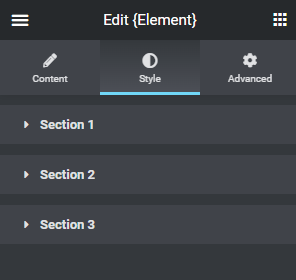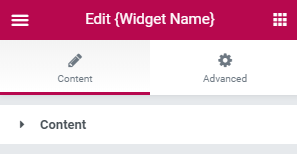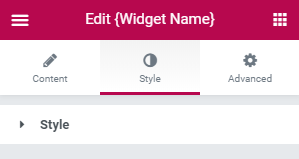# Control Section
Elementor Core Basic
Control sections are UI wrappers used to arrange controls under the tabs in the panel. These controls are divided into sections and each control must be part of a section. These sections are created using two methods: start_controls_section() creates a new section while end_controls_section() closes the section.
# Control Section Structure
Following these steps to add a new control section:
$this->start_controls_section(
'my_section',
[
'label' => esc_html__( 'My Section', 'textdomain' ),
'tab' => \Elementor\Controls_Manager::TAB_CONTENT,
]
);
$this->end_controls_section();
2
3
4
5
6
7
8
9
# Control Parameters
Every control has the following key parameters:
- Section Name
(string)– Unique id used in the code. - Section Setting
(array)– Extra section parameters.- Label
(string)– Label displayed to the user in the panel. - Tab
(string)– Tab where the section is located. Default iscontent. - Conditions
(array)– Control display conditions.
- Label
# Examples
# Single Section
The example below creates a single section which will be part of the "Content" tab. We need to provide the section name and extra parameters like the section label:
class Elementor_Test_Widget extends \Elementor\Widget_Base {
protected function register_controls(): void {
$this->start_controls_section(
'content_section',
[
'label' => esc_html__( 'Content', 'textdomain' ),
'tab' => \Elementor\Controls_Manager::TAB_CONTENT,
]
);
$this->add_control();
$this->add_control();
$this->add_control();
$this->end_controls_section();
}
}
2
3
4
5
6
7
8
9
10
11
12
13
14
15
16
17
18
19
20
21
22
23
This will create a new "Content" section under the "Content" tab.

# Multiple Sections
Now let's create multiple control sections for the "Content" tab:
class Elementor_Test_Widget extends \Elementor\Widget_Base {
protected function register_controls(): void {
$this->start_controls_section(
'content_section',
[
'label' => esc_html__( 'Content', 'textdomain' ),
'tab' => \Elementor\Controls_Manager::TAB_CONTENT,
]
);
$this->add_control();
$this->add_control();
$this->add_control();
$this->end_controls_section();
$this->start_controls_section(
'info_section',
[
'label' => esc_html__( 'Info', 'textdomain' ),
'tab' => \Elementor\Controls_Manager::TAB_CONTENT,
]
);
$this->add_control();
$this->add_control();
$this->add_control();
$this->end_controls_section();
}
}
2
3
4
5
6
7
8
9
10
11
12
13
14
15
16
17
18
19
20
21
22
23
24
25
26
27
28
29
30
31
32
33
34
35
36
37
38
39
This will create two sections for our controls under the "Content" tab.

# Sections in Multiple Tabs
The next step is to create new sections under the "Content" tab and under the "Style" tab. This is done be specifying the tab name under the extra parameters array.
Elementor has a predefined list of tabs that you can use, but with widgets the convention is to only use the "Content" tab and the "Style" tab.
class Elementor_Test_Widget extends \Elementor\Widget_Base {
protected function register_controls(): void {
$this->start_controls_section(
'content_section',
[
'label' => esc_html__( 'Content', 'textdomain' ),
'tab' => \Elementor\Controls_Manager::TAB_CONTENT,
]
);
$this->add_control();
$this->add_control();
$this->add_control();
$this->end_controls_section();
$this->start_controls_section(
'info_section',
[
'label' => esc_html__( 'Info', 'textdomain' ),
'tab' => \Elementor\Controls_Manager::TAB_CONTENT,
]
);
$this->add_control();
$this->add_control();
$this->add_control();
$this->end_controls_section();
$this->start_controls_section(
'style_section',
[
'label' => esc_html__( 'Style', 'textdomain' ),
'tab' => \Elementor\Controls_Manager::TAB_STYLE,
]
);
$this->add_control();
$this->add_control();
$this->add_control();
$this->end_controls_section();
}
}
2
3
4
5
6
7
8
9
10
11
12
13
14
15
16
17
18
19
20
21
22
23
24
25
26
27
28
29
30
31
32
33
34
35
36
37
38
39
40
41
42
43
44
45
46
47
48
49
50
51
52
53
54
55
In this example, we created two sections under the "Content" tab and another section under the "Style" tab.

As you can see from the code, unless we define the "tab", the section will be added to the "Content" tab by default.